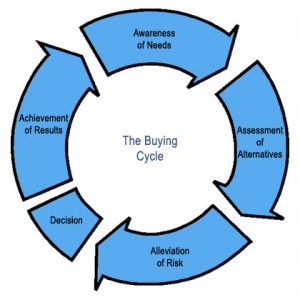Register now or log in to join your professional community.


Step 1: Need Recognition
The business must know it needs a new product, whether from internal or external sources. The product may be one that needs to be reordered, or it may be a new item for the company.
Step 2: Specific NeedThe right product is critical for the company. Some industries have standards to help determine specifications. Part numbers help identify these for some businesses. Other industries have no point of reference. The company may have ordered the product in the past. If not, then the business must specify the necessary product by using identifiers such as color or weight.
Step 3: Source OptionsThe business needs to determine where to obtain the product. The company might have an approved vendor list. If not, the business will need to search for a supplier using purchase orders or research a variety of other sources such as magazines, the Internet or sales representatives. The company will qualify the suppliers to determine the best product for the business.
Step 4: Price and TermsThe business will investigate all relevant information to determine the best price and terms for the product. This will depend on if the company needs commodities (readily available products) or specialized materials. Usually the business will look into three suppliers before it makes a final decision.
Step 5: Purchase OrderThe purchase order is used to buy materials between a buyer and seller. It specifically defines the price, specifications and terms and conditions of the product or service and any additional obligations.
Step 6: DeliveryThe purchase order must be delivered, usually by fax, mail, personally, email or other electronic means. Sometimes the specific delivery method is specified in the purchasing documents. The recipient then acknowledges receipt of the purchase order. Both parties keep a copy on file.
Step 7: ExpeditingExpedition of the purchase order addresses the timeliness of the service or materials delivered. It becomes especially important if there are any delays. The issues most often noted include payment dates, delivery times and work completion.
Step 8: Receipt and Inspection of PurchasesOnce the sending company delivers the product, the recipient accepts or rejects the items. Acceptance of the items obligates the company to pay for them.
Step 9: Invoice Approval and PaymentThree documents must match when an invoice requests payment the invoice itself, the receiving document and the original purchase order. The agreement of these documents provides confirmation from both the receiver and supplier. Any discrepancies must be resolved before the recipient pays the bill. Usually, payment is made in the form of cash, check, bank transfers, credit letters or other types of electronic transfers.
Step 10: Record MaintenanceIn the case of audits, the company must maintain proper records. These include purchase records to verify any tax information and purchase orders to confirm warranty information. Purchase records reference future purchases as well.

Usually Big companies issue a procurement plan forecasting the procurement for a year ahead in advance. This have a different cycle than the ones used for a Emergency procurement or a small budget procurement and one time procurement.
2. Cycle B :

Wait more details from our expert



